Java exception handling ppt
- 2. 2 Topics ● What is an Exception? ● What happens when an Exception occurs? ● Benefits of Exception Handling framework ● Catching exceptions with try-catch ● Catching exceptions with finally ● Throwing exceptions ● Rules in exception handling ● Exception class hierarchy ● Checked exception and unchecked exception ● Creating your own exception class ● Assertions
- 3. 3 What is anWhat is an Exception?Exception?
- 4. 4 What is an Exception? ● Exceptional event ● Error that occurs during runtime ● Cause normal program flow to be disrupted ● Examples – Divide by zero errors – Accessing the elements of an array beyond its range – Invalid input – Hard disk crash – Opening a non-existent file – Heap memory exhausted
- 5. 5 Exception Example 1 class DivByZero { 2 public static void main(String args[]) { 3 System.out.println(3/0); 4 System.out.println(“Pls. print me.”); 5 } 6 }
- 6. 6 Example: Default Exception Handling ● Displays this error message Exception in thread "main" java.lang.ArithmeticException: / by zero at DivByZero.main(DivByZero.java:3) ● Default exception handler – Provided by Java runtime – Prints out exception description – Prints the stack trace ● Hierarchy of methods where the exception occurred – Causes the program to terminate
- 7. 7 What Happens WhenWhat Happens When an Exception Occurs?an Exception Occurs?
- 8. 8 What Happens When an Exception Occurs? ● When an exception occurs within a method, the method creates an exception object and hands it off to the runtime system – Creating an exception object and handing it to the runtime system is called “throwing an exception” – Exception object contains information about the error, including its type and the state of the program when the error occurred
- 9. 9 What Happens When an Exception Occurs? ● The runtime system searches the call stack for a method that contains an exception handler
- 10. 10 What Happens When an Exception Occurs? ● When an appropriate handler is found, the runtime system passes the exception to the handler – An exception handler is considered appropriate if the type of the exception object thrown matches the type that can be handled by the handler – The exception handler chosen is said to catch the exception. ● If the runtime system exhaustively searches all the methods on the call stack without finding an appropriate exception handler, the runtime system (and, consequently, the program) terminates and uses the default exception handler
- 11. 11 Searching the Call Stack for an Exception Handler
- 12. 12 Benefits of ExceptionBenefits of Exception Handling FrameworkHandling Framework
- 13. 13 Benefits of Java Exception Handling Framework ● Separating Error-Handling code from “regular” business logic code ● Propagating errors up the call stack ● Grouping and differentiating error types
- 14. 14 Separating Error Handling Code from Regular Code ● In traditional programming, error detection, reporting, and handling often lead to confusing spaghetti code ● Consider pseudocode method here that reads an entire file into memory readFile { open the file; determine its size; allocate that much memory; read the file into memory; close the file; }
- 15. 15 Traditional Programming: No separation of error handling code ● In traditional programming, To handle such cases, the readFile function must have more code to do error detection, reporting, and handling. errorCodeType readFile { initialize errorCode = 0; open the file; if (theFileIsOpen) { determine the length of the file; if (gotTheFileLength) { allocate that much memory; if (gotEnoughMemory) { read the file into memory; if (readFailed) { errorCode = -1; } } else { errorCode = -2; }
- 16. 16 Traditional Programming: No separation of error handling code ● } else { errorCode = -3; } close the file; if (theFileDidntClose && errorCode == 0) { errorCode = -4; } else { errorCode = errorCode and -4; } } else { errorCode = -5; } return errorCode; }
- 17. 17 Separating Error Handling Code from Regular Code ● Exceptions enable you to write the main flow of your code and to deal with the exceptional cases elsewhere readFile { try { open the file; determine its size; allocate that much memory; read the file into memory; close the file; } catch (fileOpenFailed) { doSomething; } catch (sizeDeterminationFailed) { doSomething; } catch (memoryAllocationFailed) { doSomething; } catch (readFailed) { doSomething; } catch (fileCloseFailed) { doSomething; } }
- 18. 18 Separating Error Handling Code from Regular Code ● Note that exceptions don't spare you the effort of doing the work of detecting, reporting, and handling errors, but they do help you organize the work more effectively.
- 19. 19 Propagating Errors Up the Call Stack ● Suppose that the readFile method is the fourth method in a series of nested method calls made by the main program: method1 calls method2, which calls method3, which finally calls readFile ● Suppose also that method1 is the only method interested in the errors that might occur within readFile. method1 { call method2; } method2 { call method3; } method3 { call readFile; }
- 20. 20 Traditional Way of Propagating Errors method1 { errorCodeType error; error = call method2; if (error) doErrorProcessing; else proceed; } errorCodeType method2 { errorCodeType error; error = call method3; if (error) return error; else proceed; } errorCodeType method3 { errorCodeType error; error = call readFile; if (error) return error; else proceed; ● Traditional error- notification techniques force method2 and method3 to propagate the error codes returned by readFile up the call stack until the error codes finally reach method1—the only method that is interested in them.
- 21. 21 Using Java Exception Handling method1 { try { call method2; } catch (exception e) { doErrorProcessing; } } method2 throws exception { call method3; } method3 throws exception { call readFile; } ● A method can duck any exceptions thrown within it, thereby allowing a method farther up the call stack to catch it. Hence, only the methods that care about errors have to worry about detecting errors ● Any checked exceptions that can be thrown within a method must be specified in its throws clause.
- 22. 22 Grouping and Differentiating Error Types ● Because all exceptions thrown within a program are objects, the grouping or categorizing of exceptions is a natural outcome of the class hierarchy ● An example of a group of related exception classes in the Java platform are those defined in java.io — IOException and its descendants – IOException is the most general and represents any type of error that can occur when performing I/O – Its descendants represent more specific errors. For example, FileNotFoundException means that a file could not be located on disk.
- 23. 23 Grouping and Differentiating Error Types ● A method can write specific handlers that can handle a very specific exception ● The FileNotFoundException class has no descendants, so the following handler can handle only one type of exception. catch (FileNotFoundException e) { ... }
- 24. 24 Grouping and Differentiating Error Types ● A method can catch an exception based on its group or general type by specifying any of the exception's superclasses in the catch statement. For example, to catch all I/O exceptions, regardless of their specific type, an exception handler specifies an IOException argument. // Catch all I/O exceptions, including // FileNotFoundException, EOFException, and so on. catch (IOException e) { ... }
- 25. 25 Catching ExceptionsCatching Exceptions with try-catchwith try-catch
- 26. 26 Catching Exceptions: The try-catch Statements ● Syntax: try { <code to be monitored for exceptions> } catch (<ExceptionType1> <ObjName>) { <handler if ExceptionType1 occurs> } ... } catch (<ExceptionTypeN> <ObjName>) { <handler if ExceptionTypeN occurs> }
- 27. 27 Catching Exceptions: The try-catch Statements 1 class DivByZero { 2 public static void main(String args[]) { 3 try { 4 System.out.println(3/0); 5 System.out.println(“Please print me.”); 6 } catch (ArithmeticException exc) { 7 //Division by zero is an ArithmeticException 8 System.out.println(exc); 9 } 10 System.out.println(“After exception.”); 11 } 12 }
- 28. 28 Catching Exceptions: Multiple catch 1 class MultipleCatch { 2 public static void main(String args[]) { 3 try { 4 int den = Integer.parseInt(args[0]); 5 System.out.println(3/den); 6 } catch (ArithmeticException exc) { 7 System.out.println(“Divisor was 0.”); 8 } catch (ArrayIndexOutOfBoundsException exc2) { 9 System.out.println(“Missing argument.”); 10 } 11 System.out.println(“After exception.”); 12 } 13 }
- 29. 29 Catching Exceptions: Nested try's class NestedTryDemo { public static void main(String args[]){ try { int a = Integer.parseInt(args[0]); try { int b = Integer.parseInt(args[1]); System.out.println(a/b); } catch (ArithmeticException e) { System.out.println(“Div by zero error!"); } //continued...
- 30. 30 Catching Exceptions: Nested try's } catch (ArrayIndexOutOfBoundsException) { System.out.println(“Need 2 parameters!"); } } }
- 31. 31 Catching Exceptions: Nested try's with methods 1 class NestedTryDemo2 { 2 static void nestedTry(String args[]) { 3 try { 4 int a = Integer.parseInt(args[0]); 5 int b = Integer.parseInt(args[1]); 6 System.out.println(a/b); 7 } catch (ArithmeticException e) { 8 System.out.println("Div by zero error!"); 9 } 10 } 11 //continued...
- 32. 32 Catching Exceptions: Nested try's with methods 12 public static void main(String args[]){ 13 try { 14 nestedTry(args); 15 } catch (ArrayIndexOutOfBoundsException e) { 16 System.out.println("Need 2 parameters!"); 17 } 18 } 19 }
- 33. 33 Catching ExceptionsCatching Exceptions with finallywith finally
- 34. 34 Catching Exceptions: The finally Keyword ● Syntax: try { <code to be monitored for exceptions> } catch (<ExceptionType1> <ObjName>) { <handler if ExceptionType1 occurs> } ... } finally { <code to be executed before the try block ends> } ● Contains the code for cleaning up after a try or a catch
- 35. 35 Catching Exceptions: The finally Keyword ● Block of code is always executed despite of different scenarios: – Forced exit occurs using a return, a continue or a break statement – Normal completion – Caught exception thrown ● Exception was thrown and caught in the method – Uncaught exception thrown ● Exception thrown was not specified in any catch block in the method
- 36. 36 Catching Exceptions: The finally Keyword 1 class FinallyDemo { 2 static void myMethod(int n) throws Exception{ 3 try { 4 switch(n) { 5 case 1: System.out.println("1st case"); 6 return; 7 case 3: System.out.println("3rd case"); 8 throw new RuntimeException("3!"); 9 case 4: System.out.println("4th case"); 10 throw new Exception("4!"); 11 case 2: System.out.println("2nd case"); 12 } 13 //continued...
- 37. 37 Catching Exceptions: The finally Keyword 14 } catch (RuntimeException e) { 15 System.out.print("RuntimeException: "); 16 System.out.println(e.getMessage()); 17 } finally { 18 System.out.println("try-block entered."); 19 } 20 } 21 //continued...
- 38. 38 Catching Exceptions: The finally Keyword 22 public static void main(String args[]){ 23 for (int i=1; i<=4; i++) { 24 try { 25 FinallyDemo.myMethod(i); 26 } catch (Exception e){ 27 System.out.print("Exception caught: "); 28 System.out.println(e.getMessage()); 29 } 30 System.out.println(); 31 } 32 } 33 }
- 40. 40 Throwing Exceptions: The throw Keyword ● Java allows you to throw exceptions (generate exceptions) throw <exception object>; ● An exception you throw is an object – You have to create an exception object in the same way you create any other object ● Example: throw new ArithmeticException(“testing...”);
- 41. 41 Example: Throwing Exceptions 1 class ThrowDemo { 2 public static void main(String args[]){ 3 String input = “invalid input”; 4 try { 5 if (input.equals(“invalid input”)) { 6 throw new RuntimeException("throw demo"); 7 } else { 8 System.out.println(input); 9 } 10 System.out.println("After throwing"); 11 } catch (RuntimeException e) { 12 System.out.println("Exception caught:" + e); 13 } 14 } 15 }
- 42. 42 Rules in ExceptionRules in Exception HandlingHandling
- 43. 43 Rules on Exceptions ● A method is required to either catch or list all exceptions it might throw – Except for Error or RuntimeException, or their subclasses ● If a method may cause an exception to occur but does not catch it, then it must say so using the throws keyword – Applies to checked exceptions only ● Syntax: <type> <methodName> (<parameterList>) throws <exceptionList> { <methodBody> }
- 44. 44 Example: Method throwing an Exception 1 class ThrowingClass { 2 static void meth() throws ClassNotFoundException { 3 throw new ClassNotFoundException ("demo"); 4 } 5 } 6 class ThrowsDemo { 7 public static void main(String args[]) { 8 try { 9 ThrowingClass.meth(); 10 } catch (ClassNotFoundException e) { 11 System.out.println(e); 12 } 13 } 14 }
- 46. 46 The Error and Exception Classes ● Throwable class – Root class of exception classes – Immediate subclasses ● Error ● Exception ● Exception class – Conditions that user programs can reasonably deal with – Usually the result of some flaws in the user program code – Examples ● Division by zero error ● Array out-of-bounds error
- 47. 47 The Error and Exception Classes ● Error class – Used by the Java run-time system to handle errors occurring in the run-time environment – Generally beyond the control of user programs – Examples ● Out of memory errors ● Hard disk crash
- 48. 48 Exception Classes and Hierarchy
- 49. 49 Exception Classes and Hierarchy ● Multiple catches should be ordered from subclass to superclass. 1 class MultipleCatchError { 2 public static void main(String args[]){ 3 try { 4 int a = Integer.parseInt(args [0]); 5 int b = Integer.parseInt(args [1]); 6 System.out.println(a/b); 7 } catch (Exception ex) { 8 } catch (ArrayIndexOutOfBoundsException e) { 9 } 10 } 11 }
- 50. 50 Checked Exceptions &Checked Exceptions & Unchecked ExceptionsUnchecked Exceptions
- 51. 51 Checked and Unchecked Exceptions ● Checked exception – Java compiler checks if the program either catches or lists the occurring checked exception – If not, compiler error will occur ● Unchecked exceptions – Not subject to compile-time checking for exception handling – Built-in unchecked exception classes ● Error ● RuntimeException ● Their subclasses – Handling all these exceptions may make the program cluttered and may become a nuisance
- 52. 52 Creating Your OwnCreating Your Own Exception ClassException Class
- 53. 53 Creating Your Own Exception Class ● Steps to follow – Create a class that extends the RuntimeException or the Exception class – Customize the class ● Members and constructors may be added to the class ● Example: 1 class HateStringExp extends RuntimeException { 2 /* some code */ 3 }
- 54. 54 How To Use Your Own Exceptions 1 class TestHateString { 2 public static void main(String args[]) { 3 String input = "invalid input"; 4 try { 5 if (input.equals("invalid input")) { 6 throw new HateStringExp(); 7 } 8 System.out.println("Accept string."); 9 } catch (HateStringExp e) { 10 System.out.println("Hate string!”); 11 } 12 } 13 }
- 56. 56 What are Assertions? ● Allow the programmer to find out if an assumption was met – Example: month ● Extension of comments wherein the assert statement informs the person reading the code that a particular condition should always be satisfied – Running the program informs you if assertions made are true or not – If an assertion is not true, an AssertionError is thrown ● User has the option to turn it off or on at runtime
- 57. 57 Enabling or Disabling Assertions ● Program with assertions may not work properly if used by clients not aware that assertions were used in the code ● Compiling – With assertion feature: javac –source 1.4 MyProgram.java – Without the assertion feature: javac MyProgram.java ● Enabling assertions: – Use the –enableassertions or –ea switch. java –enableassertions MyProgram
- 58. 58 Assert Syntax ● Two forms: – Simpler form: assert <expression1>; where ● <expression1> is the condition asserted to be true – Other form: assert <expression1> : <expression2>; where ● <expression1> is the condition asserted to be true ● <expression2> is some information helpful in diagnosing why the statement failed
- 59. 59 Assert Syntax 1 class AgeAssert { 2 public static void main(String args[]) { 3 int age = Integer.parseInt(args[0]); 4 assert(age>0); 5 /* if age is valid (i.e., age>0) */ 6 if (age >= 18) { 7 System.out.println(“You're an adult! =)”); 8 } 9 } 10 }

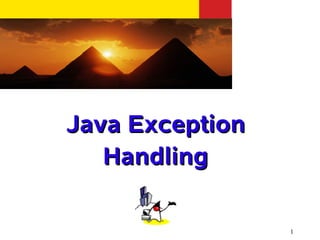



![5
Exception Example
1 class DivByZero {
2 public static void main(String args[]) {
3 System.out.println(3/0);
4 System.out.println(“Pls. print me.”);
5 }
6 }](https://image.slidesharecdn.com/javaexceptionhandling-150520125653-lva1-app6891/85/Java-exception-handling-ppt-5-320.jpg)





















![27
Catching Exceptions:
The try-catch Statements
1 class DivByZero {
2 public static void main(String args[]) {
3 try {
4 System.out.println(3/0);
5 System.out.println(“Please print me.”);
6 } catch (ArithmeticException exc) {
7 //Division by zero is an ArithmeticException
8 System.out.println(exc);
9 }
10 System.out.println(“After exception.”);
11 }
12 }](https://image.slidesharecdn.com/javaexceptionhandling-150520125653-lva1-app6891/85/Java-exception-handling-ppt-27-320.jpg)
![28
Catching Exceptions:
Multiple catch
1 class MultipleCatch {
2 public static void main(String args[]) {
3 try {
4 int den = Integer.parseInt(args[0]);
5 System.out.println(3/den);
6 } catch (ArithmeticException exc) {
7 System.out.println(“Divisor was 0.”);
8 } catch (ArrayIndexOutOfBoundsException exc2) {
9 System.out.println(“Missing argument.”);
10 }
11 System.out.println(“After exception.”);
12 }
13 }](https://image.slidesharecdn.com/javaexceptionhandling-150520125653-lva1-app6891/85/Java-exception-handling-ppt-28-320.jpg)
![29
Catching Exceptions:
Nested try's
class NestedTryDemo {
public static void main(String args[]){
try {
int a = Integer.parseInt(args[0]);
try {
int b = Integer.parseInt(args[1]);
System.out.println(a/b);
} catch (ArithmeticException e) {
System.out.println(“Div by zero error!");
}
//continued...](https://image.slidesharecdn.com/javaexceptionhandling-150520125653-lva1-app6891/85/Java-exception-handling-ppt-29-320.jpg)

![31
Catching Exceptions:
Nested try's with methods
1 class NestedTryDemo2 {
2 static void nestedTry(String args[]) {
3 try {
4 int a = Integer.parseInt(args[0]);
5 int b = Integer.parseInt(args[1]);
6 System.out.println(a/b);
7 } catch (ArithmeticException e) {
8 System.out.println("Div by zero error!");
9 }
10 }
11 //continued...](https://image.slidesharecdn.com/javaexceptionhandling-150520125653-lva1-app6891/85/Java-exception-handling-ppt-31-320.jpg)
![32
Catching Exceptions:
Nested try's with methods
12 public static void main(String args[]){
13 try {
14 nestedTry(args);
15 } catch (ArrayIndexOutOfBoundsException e) {
16 System.out.println("Need 2 parameters!");
17 }
18 }
19 }](https://image.slidesharecdn.com/javaexceptionhandling-150520125653-lva1-app6891/85/Java-exception-handling-ppt-32-320.jpg)
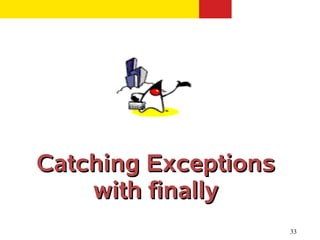
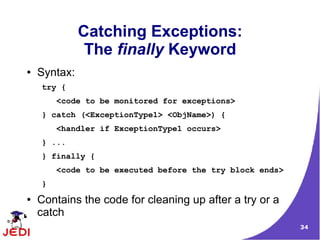
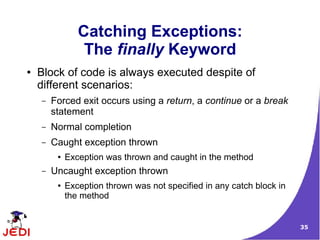


![38
Catching Exceptions:
The finally Keyword
22 public static void main(String args[]){
23 for (int i=1; i<=4; i++) {
24 try {
25 FinallyDemo.myMethod(i);
26 } catch (Exception e){
27 System.out.print("Exception caught: ");
28 System.out.println(e.getMessage());
29 }
30 System.out.println();
31 }
32 }
33 }](https://image.slidesharecdn.com/javaexceptionhandling-150520125653-lva1-app6891/85/Java-exception-handling-ppt-38-320.jpg)


![41
Example: Throwing Exceptions
1 class ThrowDemo {
2 public static void main(String args[]){
3 String input = “invalid input”;
4 try {
5 if (input.equals(“invalid input”)) {
6 throw new RuntimeException("throw demo");
7 } else {
8 System.out.println(input);
9 }
10 System.out.println("After throwing");
11 } catch (RuntimeException e) {
12 System.out.println("Exception caught:" + e);
13 }
14 }
15 }](https://image.slidesharecdn.com/javaexceptionhandling-150520125653-lva1-app6891/85/Java-exception-handling-ppt-41-320.jpg)

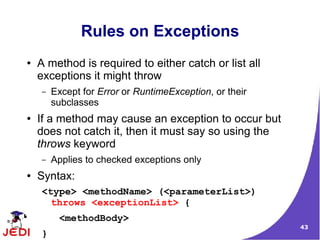
![44
Example: Method throwing an
Exception
1 class ThrowingClass {
2 static void meth() throws ClassNotFoundException {
3 throw new ClassNotFoundException ("demo");
4 }
5 }
6 class ThrowsDemo {
7 public static void main(String args[]) {
8 try {
9 ThrowingClass.meth();
10 } catch (ClassNotFoundException e) {
11 System.out.println(e);
12 }
13 }
14 }](https://image.slidesharecdn.com/javaexceptionhandling-150520125653-lva1-app6891/85/Java-exception-handling-ppt-44-320.jpg)

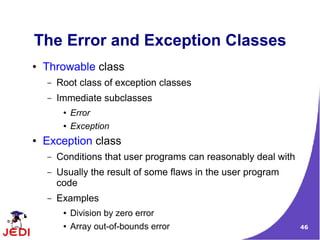


![49
Exception Classes and Hierarchy
● Multiple catches should be ordered from subclass
to superclass.
1 class MultipleCatchError {
2 public static void main(String args[]){
3 try {
4 int a = Integer.parseInt(args [0]);
5 int b = Integer.parseInt(args [1]);
6 System.out.println(a/b);
7 } catch (Exception ex) {
8 } catch (ArrayIndexOutOfBoundsException e) {
9 }
10 }
11 }](https://image.slidesharecdn.com/javaexceptionhandling-150520125653-lva1-app6891/85/Java-exception-handling-ppt-49-320.jpg)




![54
How To Use Your Own Exceptions
1 class TestHateString {
2 public static void main(String args[]) {
3 String input = "invalid input";
4 try {
5 if (input.equals("invalid input")) {
6 throw new HateStringExp();
7 }
8 System.out.println("Accept string.");
9 } catch (HateStringExp e) {
10 System.out.println("Hate string!”);
11 }
12 }
13 }](https://image.slidesharecdn.com/javaexceptionhandling-150520125653-lva1-app6891/85/Java-exception-handling-ppt-54-320.jpg)




![59
Assert Syntax
1 class AgeAssert {
2 public static void main(String args[]) {
3 int age = Integer.parseInt(args[0]);
4 assert(age>0);
5 /* if age is valid (i.e., age>0) */
6 if (age >= 18) {
7 System.out.println(“You're an adult! =)”);
8 }
9 }
10 }](https://image.slidesharecdn.com/javaexceptionhandling-150520125653-lva1-app6891/85/Java-exception-handling-ppt-59-320.jpg)
